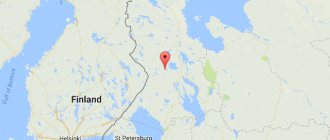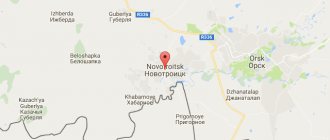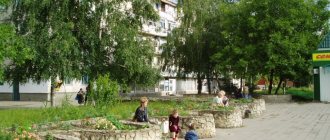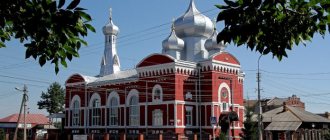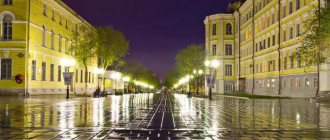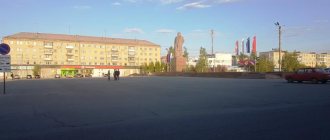We bring to your attention a comprehensive overview post about the districts of Tver. We have analyzed all the noteworthy sources and sorted out useful information. Latest news, answers to frequently asked questions, the main thing from TravelAsk reviews - only verified information.
This publication can be trusted to provide a summary of the most up-to-date information, which we update as new information becomes available. As soon as something important appears about Tver districts, we add it to the review. Don't look elsewhere for information - we've collected here everything you wanted to know and a little more. 
The beautiful and ancient city of Tver
Districts of Tver
Tver is a city in central Russia on the banks of the Volga. Its area is only 152 km² and its population is approximately 425,000 people.
The city is divided into 4 districts:
- Zavolzhsky;
- Moscow;
- Proletarian;
- Central.
Districts of Tver on the map
They, in turn, are divided into municipalities and microdistricts.
The final territorial division of Tver took place only in 1976.
Central district of Tver - the historical part of the city
This is the smallest district of Tver, it occupies only 6.9 km². About 55,000 people live here.
Tourists most often stay in this area. Hotels, hostels, and small hotels have been built for them.
This is the most prestigious area of the city, so real estate here is the most expensive. The center is built up with historical low-rise buildings, standing close to each other. Modern multi-storey buildings and residential complexes are being built on the outskirts. The cost of apartments starts on average from 400,000 rubles per square meter. But there is little free real estate; buying an apartment here can be problematic; most offers for sale are on the secondary market.
Top view of the Central district of Tver
In the Central region there are all administrative and government buildings, universities and institutes, medical institutions (a hospital campus has been built), sports centers and concert halls.
There are many parks, squares, boulevards and pedestrian streets. There are places to have fun - cinemas, museums, cafes and restaurants.
The environment is good, there are few industrial enterprises here, so their harm to the environment is minimal.
Transport accessibility is also not satisfactory - public transport runs frequently, there are many routes, and there are stops literally every few hundred meters. However, the streets are narrow, there are a lot of cars, all this leads to traffic jams, especially during rush hours. The area itself is well-maintained, but there are also abandoned corners. For example, in the center there are many private dilapidated houses where no one has lived for a long time.
Microdistrict Zamache
Looking at it, it’s hard to believe that this is the very center of the city. Almost all the buildings here are small wooden ancient buildings. This is the historical core of Tver. There are many attractions here.
- Chaplin's house.
- The White Trinity Cathedral is the oldest building in Tver.
- Golovinskaya column.
Low wooden houses are typical buildings in Zamachye
THIS IS INTERESTING. There is also a modern landmark - a simple hostel at the address: st. Uchitelskaya, 13/34. The online series “House Tyrant” was filmed here. Today, construction is underway in this microdistrict, new houses are being rapidly erected, but construction is mostly spot-on, there are no neighborhoods or residential complexes.
Tver-gorodok: history and sights
Tver was first mentioned in 1208-1209. in the Laurentian Chronicle. Until this point, the settlement already existed in the 9th-10th centuries, but did not have a clear name and status. The Tver lands were divided between the Vladimir, Novgorod and Smolensk principalities. Only after they passed to Alexander Nevsky, and from him, in turn, to his brother Yaroslav, did Tver become a large and strong principality. The favorable geographical position of Tver allowed the city to quickly develop trade relations, but Tver also experienced attacks from invaders more than once.
The historical center of Tver of those years has not been preserved. First, Tver was attacked by the Mongol-Tatars. Then Ivan the Terrible in 1569 took up arms against the Novgorod lands and began his campaign with the destruction of the Tver possessions. During the Time of Troubles, Tver was attacked by the Poles more than once.
Constant wars depleted the economy of Tver, and it lost its influence for some time. But the construction of St. Petersburg and the Vyshnevolotsk water system returned Tver to the role of a transshipment and port center. Under Peter, Tver was actively built up, many buildings have been preserved - the house of the merchant Arefiev, where Peter stayed when he came to Tver, the stone Assumption Church. But the Kremlin was destroyed by fire in 1763, because the central part of the city was made of wood. But that same year, Catherine issued a decree to build up and improve the city.
The layout of the city repeats St. Petersburg and... Versailles - it was this architectural technique that was used by the builders. Thanks to Catherine’s decree, we see Tver today exactly like this - with a beautiful ancient center, wide promenades, surrounded by greenery. The main building of that time can be considered the Imperial Travel Palace, built according to the design of M. Kazakov.
The palace served as a resting place for royalty on trips from St. Petersburg to Moscow. The Empress herself more than once gave receptions and dinner parties in the palace, which were attended by Prince Potemkin, Count Shuvalov, and foreign diplomats. Now the palace houses the Tver Regional Art Gallery. But the palace building itself is in a deplorable state and restoration work is not visible. The façade has faded and collapsed, with cracks all over the walls.
The former luxurious decoration inside has also not been preserved. During the war, the German headquarters was located in the palace and during the retreat of the troops it was set on fire. And although the palace officially received museum status in 1961, this, unfortunately, did not affect its restoration in any way. But you can visit the museum itself; the exhibitions there are very interesting.
Next to the palace there is a building of a former real school, now the Tver State United Museum is located here. Be sure to visit it with your child. There is a very complete collection of exhibits telling about the life and development of the Tver region, excavation objects, wildlife, all the milestones of ancient and modern history. The exhibition is not boring, it is decent and will be interesting even to a small child.
And when you get tired of museums, you can relax in the city park, which is located right behind the palace and museum, on the embankment. It offers a beautiful view of the Volga, bridges, and churches. In the park itself you can ride, for example, on a Ferris wheel - the view is mesmerizing. The attractions themselves are still from the Soviet era, but there are not many people, even on weekends, and there are practically no queues. A big disadvantage of a holiday can be the lack of a normal cafe or restaurant.
There are only summer cafes in the park, where it is unclear what to feed the child. There is a pizzeria and an Arabic cafe in the alley nearby. I won’t say anything about the pizzeria; fortunately, the cafe also served Russian cuisine. Decent and budget-friendly, but for a baby, it is better to take ready-made baby food with you. Another little tip: in a cafe, not only visitors can use the toilet.
After lunch, having gained strength, you can take a walk around the city center. Tver is so compact that almost all the attractions are concentrated in one place and are located within walking distance. Leaving your car in the parking lot and taking a city map (you can buy it at any newsstand in Tver), walking around the city is a pleasure.
The decoration of Tver is the square on which the Tver administration building stands - the former provincial government and the Treasury Chamber. Here Saltykov-Shchedrin served as vice-governor. The writer's museum is located on the outskirts of the city, in the house where he lived. There is an exhibition there that tells not only about his writing, but also about his public service.
The Tver region, which is located on the other bank of the Volga, is logically named Zavolzhsky. You can get to it via one of two bridges - the old one (1900) and the new one (1956). While still walking along the embankment, you will probably notice a large and unusual monument on the opposite side. Having moved to the other side of the Volga, you will find yourself on another embankment, no less attractive.
The center of walks and the place for wedding processions is the monument to Afanasy Nikitin. This famous merchant and traveler is an unspoken symbol of Tver. He is famous for having traveled to India thirty years before Vasco da Gama discovered this country. True, Nikitin succeeded in this by accident: during a routine trading trip, his ship was attacked by the Tatars and plundered all the goods.
Nikitin did not want to return home empty-handed and, wanting to sell off the remaining goods, began traveling on other merchant ships heading to the East. He lived in Iran for two years before he learned about India and went there. The result of the trip was Nikitin’s travel notes “Walking across Three Seas”, in which he talks in detail and impartially about his adventures in India and about the customs and people of the country.
You can walk along the embankment to the River Station. Water buses depart from here for excursions. Don't miss the last opportunity to see all the beauty of the city from board the ship, because the navigation season on the Volga is short. By the way, another mooring place is the city park. You can also go on excursions from here. Motor ships cruising along the Volga land at the River Station.
Believe me, these huge liners will not leave any child indifferent. The station itself stands at the intersection of the Tvertsa rivers (from which the name of the city comes) and, accordingly, the Volga. From the embankment you can take beautiful pictures of the St. Catherine's Convent and the Stepan Razin embankment with ancient buildings. There are also shrines in the Volga region - the Resurrection Church and the Assumption Cathedral. The construction of the monastery was associated with the name of the first Tver prince Yaroslav Yaroslavovich.
By the way, there is one stable expression associated with this monastery, which we now use without thinking about its meaning. In the 15th century, the monastery served as a place of detention for those who disagreed with the policies of Ivan the Terrible. One of them was Metropolitan Philip Kolychev. From his imprisonment in the monastery, he wrote letters to Ivan the Terrible, in which he denounced the oprichnina and criticized the tsar. And these letters were called “filkina”. From those times the expression “filkina’s letter” came about.
If you want to buy a souvenir with the symbols of the city as a souvenir, you will have to look very hard. For some reason, this is difficult and scarce in the city. You can only look at something in the foyer of museums. Otherwise, a trip to Tver is an excellent option for a one-day adventure.
Moskovsky district is a large industrial zone
It ranks second in area and number of inhabitants - almost 125,000 people live on 40.9 km².
It is located in the east of Tver. It includes several villages and towns.
This is the youngest district of Tver, formed in 1975.
There are no special attractions here, but there is a large industrial zone with enterprises and factories. Therefore, tourists can rarely be found in the Moscow region.
The environmental situation is causing concern among authorities and activists - the air is polluted, water and soil are polluted. There is also a highway to Moscow, where there are always a lot of cars. But recently, the old equipment of the factories was replaced with modern ones, which to some extent reduced the negative impact on the environment. There are not enough parks and trees in the area; there is only a small Bobachevskaya grove.
Several large shopping centers, hypermarkets, cinemas, cafes, and restaurants have been built in the area. But there are difficulties with the social infrastructure - the city hospital, several schools and kindergartens cannot cope with the number of residents, and there is a shortage of places.
The real estate is budget, all buildings are mostly new, multi-storey economy class buildings are being built. There is also a private sector with inexpensive cottages and townhouses.
Many budget economy-class houses have been built in the Moscow region
Transport in the Moskovsky district works well, especially in the part that borders the Central District. From here, residents of the area can go anywhere in Tver without any problems. But people living on the outskirts have a more difficult time - during rush hour the journey can take more than an hour.
There are tram routes almost everywhere, but there are no trams themselves.
Microdistricts of the Moskovsky district
The largest microdistricts of the Moscow District are considered:
- Chaika microdistrict;
- Southern;
- village of Bolshie Peremerki;
- the village of Krupskoy;
- village of the Chemical Institute.
Chaika is a residential area in the east of the city, bordering the village of Bobachevo. The buildings are modern, mostly five- and nine-story buildings. Real estate is inexpensive. There is a secondary school. There is little entertainment, as well as attractions.
The village of Bolshie Peremerki is characterized by an unfavorable environmental situation; the issue of resettling local residents has been repeatedly raised. This is an industrial zone with a large number of enterprises. There is also a colony and a shelter for stray dogs.
The private sector predominates in the village of Krupskaya; there are practically no multi-storey buildings. The houses are ordinary; luxury cottages are a rarity here. The air is relatively clean, there are no industries, but there is an intercity highway nearby.
The village of the Chemical Institute is distinguished by good ecology; there is a natural monument, Birch Grove.
The infrastructure is developed - there are hospitals, cultural institutions, a school, and several kindergartens.
Russians against Russians, or how to become a capital
Moscow finally absorbed the Tver principality a hundred years later. Ivan III then ruled in Moscow, and Mikhail again sat on the Tver throne, but this time Borisovich. They were relatives to each other, since Ivan was married to Maria, Mikhail’s sister. In 1467 she died, and family ties ceased to tangle Ivan’s hands. In 1483, Mikhail was also widowed. He found a new wife in Lithuania, having concluded a defensive alliance with the prince there. Ivan decided that this was an excellent reason to attack his former relative.
Ivan III. (wikipedia.org)
Tver no longer had the strength to resist. But the alliance with Lithuania was valid only on paper. Ivan did not completely finish off the enemy, limiting himself only to his humiliation. Mikhail Borisovich humbly asked for peace, broke the alliance with Lithuania and generally lost the right to any international relations. After this, Tver boyars and service people began to leave en masse for Moscow.
In 1485, the time came to put an end to almost two centuries of confrontation. Moscow clerks prepared a fake letter from Mikhail, allegedly sent by him to the Lithuanian prince Casimir. This piece of paper was enough for a new trip to Tver. Mikhail Borisovich tried to justify himself, swore his innocence, but it was all in vain. His last supporters left him, going over to the side of force. The Tver prince fled to Lithuania; he never returned to Rus', having received a rich estate from his father-in-law Casimir. The Tver principality finally lost its independence and was included in Muscovite Rus'.
It is unknown what our country would have looked like if Tver had become the main city of Rus' 700 years ago - history does not know the subjunctive mood. But then Moscow took over, and since then things in Russia have gone according to its rules. It all ended with a monstrous centralization of power and the transformation of the capital almost into a separate state, living completely differently from the rest of Russia.
Zavolzhsky district is the largest district of Tver
The district ranks first in terms of area (68.7 km²) and number of inhabitants (147,000 people).
This is a prestigious and environmentally friendly district. There are industrial enterprises, but in small numbers and mainly in outlying areas. Recently, factories changed equipment to new equipment that can capture more pollutants.
The area is green, there are many trees, there are two rivers with beautiful embankments and good beach areas. Parks and squares have been developed.
Active development of the center is underway, modern multi-storey buildings and economy class residential areas are being erected. But there is also luxury real estate. Apartments there are expensive.
All houses are of high quality, warm, equipped with all household communications. But some buildings erected during the Soviet period require major repairs or demolition.
The outskirts are also being built up, mainly with cottages and townhouses. You should be careful when buying them - some of the buildings are illegal, they can be demolished at any time.
Active construction of townhouses is underway in the Zavolzhsky district
The infrastructure is also developing, but there are still few shops, shopping centers, entertainment complexes, and not a single cinema. There are not enough public hospitals and clinics for all residents of the region. Private clinics are improving the situation a little. But in the Zavolzhsky district there is a student town with branches of large universities in the city. There are schools and kindergartens.
Transport in the area runs well, there are buses, trams, and trolleybuses. Inter-district movements do not cause difficulties for the population. But getting to neighboring districts can be difficult. There is only one bridge, so traffic jams are common. And during its major renovation, it was faster to get to the center of Tver on foot. There is talk about building another bridge, but there is no final design yet.
Microdistricts of Zavolzhsky district
The largest municipalities of the Zavolzhsky district are:
- Zatvereche;
- Youth;
- Sominka;
- village of Vagonnikov;
Zatverechye is located on the territory between the Volga and Tvertsa rivers. This is the historical part of the city.
There are many elite cottages built on the banks of reservoirs. Real estate is expensive.
The infrastructure is good, there is a shopping center, several supermarkets, schools.
Transport is uneven; it is difficult to get from the outskirts of the microdistrict to other areas. Buses, trams and trolleybuses run in the central part.
There are many attractions in Zatverechye, for example, the St. Catherine's Monastery.
Yunost is a residential area bordering an industrial zone. There are old buildings and inexpensive real estate here, since the environmental situation is still unfavorable.
Trolleybuses and trams do not reach this part of the Zavolzhsky district; only buses run.
Sominka is a microdistrict that is developing rapidly. New multi-storey buildings, business-class residential complexes, and cottage communities are being built here.
There is the necessary infrastructure - shops, schools, kindergartens, universities, a swimming pool, a library. Many shops.
THIS IS INTERESTING. Sominka is mentioned in Mikhail Krug’s famous song “We Drink Vodka.”
The village of Vagonnikov was built mainly for workers of the local plant. There are no multi-storey buildings here, only the private sector.
There is no infrastructure. The only school was closed, there are no plans to build hospitals or clinics. There are few shops.
Public transport is poor, there is only one bus and a few minibuses.
Employment
In Tver, the number of labor force aged 15 to 72 years in 2016 amounted to 689 thousand people. The employment rate among them is 66%. This figure has decreased by 1% over the past five years. The unemployment rate in Tver is 6%. Most people are employed in wholesale and retail trade, and vehicle repair. In 2015, 103.5 thousand city residents worked in this sector. Quite a lot of people are also employed in the manufacturing industry. In 2015, 98.6 thousand people worked in this area. In third place in terms of the number of employees is agriculture and forestry. 59 thousand residents work in this sector.
Approximately the same number of people are employed in such areas as construction, transport and communications, social security, education, and healthcare. The least amount of labor is employed in household activities and fishing. Over the past five years, the share of workers has increased in such areas as construction, wholesale and retail trade, hotel and restaurant business, and real estate operations. Thus, the global trend is observed. The number of people employed in agriculture and industry is decreasing, while in the service sector it is growing.
Proletarsky district - a residential part of Tver
Previously, the Proletarsky district was considered an industrial zone, practically unsuitable for living. Many factories and enterprises were built here. But in post-Soviet times, most of them went bankrupt and were closed. Today it is a residential district of Tver. About 99,000 people live on an area of 32.17 km².
Building in Proletarsky district
The area is being actively developed with economy-class houses. Modern shopping centers, shops, restaurants and cafes are also being built. New schools are opening, a Suvorov military school has been built. There are several hospitals, a stadium, and private gyms. There are several nightclubs and cinemas. Initially, real estate was inexpensive, but after the opening of a shopping mall (the largest in Tver), prices increased significantly.
After the closure of a number of industrial enterprises, the environmental situation has improved and the air has become cleaner. Trees are being planted and embankments are being improved in the area.
But despite the improvement of the territory, there are still many dilapidated and unsafe buildings in the area. For example, the formerly famous Morozov barracks and dormitories for plant workers.
Transport accessibility of Proletarka is provided by trams, minibuses and buses. However, it is difficult for residents of outlying territories to leave for other areas, even though the M-10 federal highway runs nearby. Public transport is poor and there are frequent traffic jams.
Microdistricts of Proletarsky district
The district is divided into 10 microdistricts, we will focus on the largest:
- Pervomaisky;
- Migalovo;
- Mamulino;
- Proletarka's Courtyard;
- Brusilovo.
Pervomaisky was mainly built up with five- and nine-story buildings in the 1980s. In the early 2000s, a new company entered the construction market, which was going to build modern residential areas. But one deceived its investors, so active settlement of the microdistrict began in 2011. Also in Pervomaisky many ancient wooden buildings have been preserved.
Migalovo is a former rural settlement, until 1980 it was a closed military town. There is practically no construction going on, but there is a school and a kindergarten.
Mamulino - on the site of the former village, the territory is being actively developed with modern residential complexes. Schools, kindergartens, shopping and entertainment centers are being built. There are expensive private cottages.
THIS IS INTERESTING. The famous singer Mikhail Krug lived in Mamulino.
Proletarka's courtyard is a historical architectural monument. The complex was built for the Tver Manufactory Partnership at the end of the 19th - beginning of the 20th century. This is one of the first microdistricts in Russia.
Construction of Brusilovo began in 2008, work is still underway. This is a modern microdistrict with multi-storey buildings and infrastructure facilities - a school, kindergartens, hospitals, entertainment centers and gyms.
